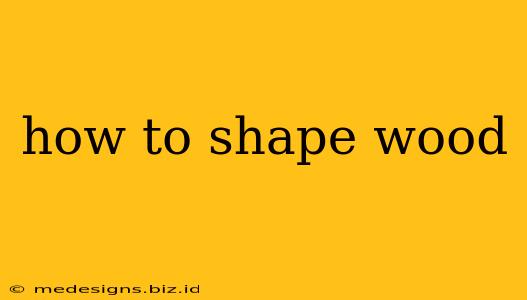Shaping wood is a rewarding skill, whether you're crafting intricate furniture, delicate sculptures, or simple, functional objects. This comprehensive guide covers various techniques and tools to help you master the art of wood shaping, regardless of your experience level. We'll explore everything from basic hand tools to power tools, providing tips and safety advice along the way.
Choosing the Right Wood
The type of wood you select significantly impacts the shaping process. Hardwoods like oak and maple are durable but require more effort to shape, while softwoods like pine and cedar are easier to work with but may be less resistant to wear and tear. Consider the project's intended use and your skill level when making your choice. Understanding wood grain is also crucial; shaping with the grain is always easier and results in a stronger, less prone to splitting, finished product.
Understanding Wood Grain
Before you even pick up a tool, familiarize yourself with the wood grain. The grain refers to the direction of the wood fibers. Shaping along the grain is much easier than shaping across the grain, which can lead to splintering and breakage. Always examine the wood carefully before beginning any shaping process.
Essential Tools for Wood Shaping
The tools you'll need depend on the project's complexity and your preferred method. However, some basic tools are essential for almost any wood shaping task.
Hand Tools:
- Hand saws: Rip saws cut with the grain, while crosscut saws cut across the grain. A coping saw is excellent for intricate cuts.
- Chisels: Used for removing wood from various surfaces, chisels come in a range of sizes and shapes.
- Spokeshaves: Ideal for smoothing curves and shaping edges.
- Files and rasps: For refining shapes and smoothing surfaces.
- Sandpaper: Essential for creating a smooth, polished finish. Use various grits, starting with coarser grits and progressing to finer ones.
- Measuring tools: Accurate measurements are crucial for consistent results. Use a ruler, tape measure, and a marking gauge.
Power Tools:
- Jigsaw: Versatile for cutting various shapes and curves.
- Band saw: Excellent for intricate cuts and shaping curves.
- Router: Used for creating decorative edges, grooves, and other detailed features.
- Belt sander: Effective for quickly shaping and smoothing larger surfaces.
- Random orbital sander: Provides a smoother finish than belt sanders.
Safety First: Always wear appropriate safety gear, including eye protection, hearing protection (when using power tools), and a dust mask.
Shaping Techniques
Several techniques can be used to shape wood, each with its advantages and disadvantages.
Carving:
Carving involves using chisels and other hand tools to remove wood and create three-dimensional shapes. It's a time-consuming but rewarding technique, ideal for intricate designs and small projects.
Whittling:
Similar to carving, whittling uses a knife to shape wood. It’s a great technique for creating small, detailed pieces.
Turning:
Wood turning utilizes a lathe to rotate a piece of wood while tools shape it. It's excellent for creating cylindrical shapes like bowls, vases, and spindles.
Sanding:
Sanding is the final step in many wood shaping projects. It smooths the surface and prepares it for finishing. Start with coarser grit sandpaper and gradually move to finer grits for a smooth, polished finish.
Finishing Touches
Once you've shaped your wood, it's time to apply a finish. This protects the wood from damage and enhances its appearance. Options include paint, varnish, stain, and oil. Choosing the right finish depends on the wood type, the project's intended use, and your personal preference.
Practice Makes Perfect
Shaping wood takes practice and patience. Start with simple projects and gradually increase the complexity as you gain experience. Don't be afraid to experiment and learn from your mistakes. With time and dedication, you'll master the art of wood shaping and create beautiful, functional pieces.
This comprehensive guide provides a solid foundation for your wood shaping journey. Remember to prioritize safety and enjoy the creative process!
